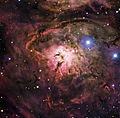Barkas:Lagoon Nebula.jpg

Gedhéning pratuduh iki: 610 × 599 piksel Résolusi liya: 244 × 240 piksel | 489 × 480 piksel | 782 × 768 piksel | 1.043 × 1.024 piksel | 1.841 × 1.808 piksel.
Berkas asli (1.841 × 1.808 piksel, ukuran barkas: 2,92 MB, jinis MIME: image/jpeg)
Sajarahing berkas
Klik ing tanggal/wektuné saprelu ndeleng rupané barkasé nalika tanggal iku.
| Tanggal/Wektu | Gambar cilik | Alang ujur | Naraguna | Tanggepan | |
|---|---|---|---|---|---|
| saiki | 4 Maret 2014 00.20 |  | 1.841 × 1.808 (2,92 MB) | Lmbuga | Putting the nebula in the center of the image |
| 9 Agustus 2012 07.48 |  | 2.027 × 2.064 (1,59 MB) | Fabian RRRR | higher resolution | |
| 22 April 2010 07.32 |  | 1.280 × 1.303 (317 KB) | EricHS211 | {{Information |Description={{en|1=Infrared view of the Cat’s Paw Nebula (NGC 6334) taken by VISTA. NGC 6334 is a vast region of star formation about 5500 light-years from Earth in the constellation of Scorpius. The whole gas cloud is about 50 light-year |
Panggunaning berkas
Ora ana kaca kang nganggo barkas iki.
Panggunané barkas sajagat
Wiki liya ngisor iki nganggo barkas iki:
- Kanggo ing ady.wikipedia.org
- Kanggo ing alt.wikipedia.org
- Kanggo ing av.wikipedia.org
- Kanggo ing bn.wikipedia.org
- Kanggo ing cs.wikipedia.org
- Kanggo ing cv.wikipedia.org
- Kanggo ing de.wikipedia.org
- Kanggo ing en.wikipedia.org
- Kanggo ing et.wikipedia.org
- Kanggo ing fr.wikipedia.org
- Kanggo ing hu.wikipedia.org
- Kanggo ing kaa.wikipedia.org
- Kanggo ing kk.wikipedia.org
- Kanggo ing koi.wikipedia.org
- Kanggo ing ko.wikipedia.org
- Kanggo ing kv.wikipedia.org
- Kanggo ing lez.wikipedia.org
- Kanggo ing mdf.wikipedia.org
- Kanggo ing mg.wikipedia.org
- Kanggo ing mk.wikipedia.org
- Kanggo ing mrj.wikipedia.org
- Kanggo ing olo.wikipedia.org
- Kanggo ing os.wikipedia.org
- Kanggo ing pl.wikipedia.org
- Kanggo ing pt.wikipedia.org
- Kanggo ing ru.wikipedia.org
- Kanggo ing sah.wikipedia.org
- Kanggo ing sh.wikipedia.org
- Kanggo ing sk.wikipedia.org
Deleng naraguna liyané sadonya saka kaca iki.

